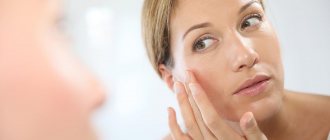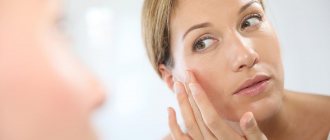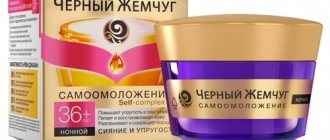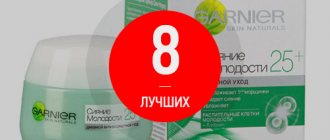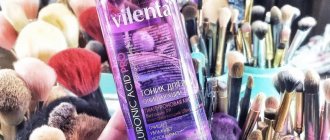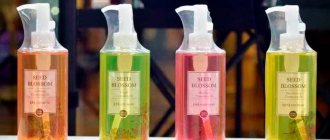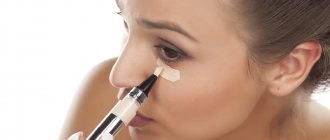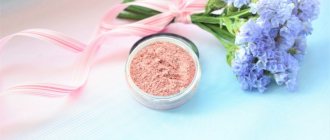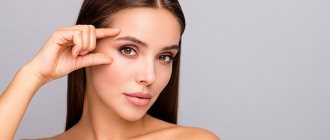Home » Face
Category: Face
While many people skip applying primer as an unimportant step, it only takes a few minutes to add it to your makeup routine. It can have a huge impact on your finished look. Primer smoothes the surface of your skin, minimizing the appearance of fine lines and pores, evens out skin tone, and helps your makeup stay in place and smudge-free all day long. This article will help you choose the right primer and you will learn how to apply it correctly.
- What is a primer?
- What is a face primer for?
- How to choose a primer?
- Benefits of using and types of facial primers
- Is the primer silicone based or water based?
- Can I use primer instead of foundation?
- How to use face primer
- How to use face primer under makeup: step-by-step video instructions
- Rating of the best face primers according to makeup artists
- Rating of the best budget face primers
What is a primer?
Simply put, a primer is exactly what its name implies: it's a prep product that's applied after treating your skin to create the perfect canvas to hold any makeup that comes later—like a foundation, tinted moisturizer, or concealer. Your primer can come in the form of a hyaluronic acid-spike facial serum that enhances hydration, a sunscreen that protects and softens the appearance of pores, or a traditional silicone-based primer that smooths and blurs.
It's worth noting that the newest primers don't just smooth out skin, keep makeup in place, and blur pores almost to the point of invisibility. They can also brighten, fade fine lines and wrinkles, smooth out acne, and add moisture. Some can even give the skin a temporary facelift, all without feeling heavy.
Bottom line: If you're wondering whether you need a primer in your life, just ask yourself how satisfied you are with the look, feel, and finish of your facial makeup. If there's something you're not happy with—perhaps you want to add more overall glow or take away the shine from your T—a zone primer might be just what you need.
Famous manufacturers
By visiting an online store or a real market, you can purchase a quality makeup product. But it’s best to do this only after you read reviews about the manufacturer and its products. And also carefully study the photos of face primers to buy exactly what you read about.
Sometimes girls stop at choosing budget options without delving into the composition of the cosmetics and the brand. An inexpensive product may suit you, but in order not to make a mistake with your choice, you need to study the composition. A high price does not always mean decent quality of the product.
Based on real reviews from women, we can conclude that popular manufacturers are:
- MAS is a company that creates unique products that have the stated effect.
- L'Oreal Paris presents a huge selection of products. Their cost is high, but the quality matches the price.
- Letual cosmetics are also very popular among women due to the effect that remains from the products of this manufacturer.
You should also highlight , NYX, etc. It should be noted that products from some domestic manufacturers can have a good effect.
What is a face primer for?
Whether or not you think using a primer is necessary is 100 percent up to you. You may find that primers don't make a noticeable difference to your facial makeup, in which case skip this step. However, it may also mean that you haven't found the right remedy yet. While some makeup artists and editors have a few favorites, there are other experts who feel quite the opposite, believing it's an unnecessary extra step that doesn't make a difference to the look and longevity of your facial makeup. However, before choosing a primer, do your research, get recommendations, and try different formulas in the store.
Let's look at some more useful properties of the base
Almost all primers have a sun protection factor. And remember that the epidermis needs to be protected from the sun not only in summer. After all, the sun shines all year round. You don’t want to have age spots on your face when you’re 20-40 years old, do you?
Vitamins and antioxidants are necessary to restore the skin. Collagen is restored, giving firmness and elasticity.
How to choose a primer?
Decide what you want
Are you most concerned about wrinkles and fine lines? Bleaching? Toning shine for oily skin? There are tons of primers on the market, so take the time to study your skin and think about what will work best for you. Check labels or research online to find a primer that will suit your unique needs.
- If you're concerned about enlarged pores or wrinkles, look for pore-reducing and anti-aging foundations
- Primers should always be used if you are going to airbrush your makeup.
Assess your skin and decide if you need a color-correcting primer.
If you have dark spots on your skin or dark circles under your eyes, redness or yellowness, you can find a tinted primer that will counteract the discoloration. Some colors cancel each other out, so if you have red skin, the color opposite red on the color wheel (green) will cancel out the red.
- Keep in mind that you don't have to use a correcting primer. You can absolutely use clear.
- A primer with a greenish tint can correct redness. This is especially helpful if you get a sunburn on your face.
- A yellow primer works for light red or pinkish complexions.
- If you have bluish dark spots, hyperpigmentation, or bruising, try an orange or peach-toned primer.
- If your skin is yellowish, try a tinted lavender primer.
Find out your skin type - oily, dry or normal?
Primers have different ingredients, weights and textures that will work better with different skin types. If you're not sure what kind of skin you have, wash your face with a gentle cleanser and let it air dry. How does your skin feel after 15-20 minutes?
- If your face feels damp or oily, you have oily skin. Try a mattifying primer to tone shine and absorb oil. Primers with salicylic acid also absorb excess oil.
- If your skin feels tight or dry, you have dry skin. Look for a gel base or brightening primer that won't dry out your skin.
- If your skin feels soft and clean, you have normal skin. Experiment with different primers to see which works best and gives you the effect you want.
Benefits of using and types of facial primers
To make your makeup look 100,000 percent better. It's really that simple. Makeup with a gel, cream, or liquid primer smoothes your skin, filling in tiny creases, enlarged pores, tightness and flaking, and uneven textures, creating nothing but a smooth surface for your makeup to glide on.
Makeup primer basically blurs, conceals, and evens out your skin's texture (not completely—it's not magic, but still to a noticeable degree). And because your makeup isn't competing with roughness and oil stains, it sticks to your face for hours longer than usual.
Primer comes in a ton of different shapes, just in case you want to prime your entire face. There are lip primers (to help keep your lipstick smooth and long-lasting), eyelash primers (to prevent clumps and lengthen lashes), eyelid primers (to prevent creasing, fading, and smudging), and face primers.
Facial primers also come in different formulas:
- moisturizers for dry skin,
- matting
- for oily skin,
- color correcting for redness
But really, all primers come down to two important, distinct categories: silicone-based or water-based formulas.
Features of application
To achieve the desired result, you should know and take into account some features of using a primer.
- Purchase a special brush (concealer) that ensures a comfortable and as even application of the product on the skin surface using patting and tapping movements.
- Apply the composition only to clean and dry facial skin. If you cannot do without using a caring cream, then be sure to wait until it is completely absorbed and only then apply the primer.
- If you want to apply such a product to the skin in the eye area, then perform the manipulation on the upper and lower eyelids.
- It is allowed to apply a thin layer of a primer specially designed for this purpose on the skin of the lips.
- Transparent compositions are produced for eyelashes, applied in a thin layer, due to which the makeup will look harmonious and neat.
Is the primer silicone based or water based?
Silicone primers give your face a super smooth, silky, soft feel that allows your makeup to glide onto your skin without sinking into pores and creases. Silicones also form a protective little shield over your skin, trapping moisture to keep your skin hydrated and protected. You'll know you have a silicone primer if one of the first five ingredients ends up in a cone or siloxane (eg, cone dimethi, conuspolisily, tri siloxane, cyclopenta siloxane, rec.). It's not an exact science, but if the -cones or -siloxanes are missing, you probably have a water-based primer.
And water-based primers are essentially lightweight moisturizers that leave your skin feeling slightly hydrated. I personally am not a fan of water-based primers. I don't think they do anything special for your makeup, especially if you're already wearing moisturizer, and they don't offer any of the same skin-smoothing properties as silicone primers.
This doesn't mean that silicone primers are suitable for everyone. Some people hate the feel of silicones or swear that silicones don't suit them and simply prefer the finish they get with a water-based primer.
Can I use primer instead of foundation?
If you use a water-based primer, you're basically just adding another layer of moisture to your skin (and maybe even some color-correcting or brightening powers, depending on the formula you get), which is always a plus. And if you use a silicone-based primer, you mattify your face by blurring the pores and also lock in moisture into your skin so it doesn't dry out. Basically, wearing just a primer without foundation can still give you skin care benefits.
How to use face primer
Unlike products that block your makeup, like powders or setting sprays, primers are almost always applied after your last skincare step and before your makeup. As for application, makeup artists Allan Avendaño, Mary Phillips, and Robin Black recommend using your fingers to apply primer, as they say it's the best and easiest way to blend everything in for a seamless finish.
“The makeup brush will just smear the primer around,” says Phillips.
He also recommends giving the primer a full minute to dry before applying anything on top to avoid ruining your makeup.
“The trick with any primer is to make sure it's applied in a small amount and it's completely mixed in first [before going into the foundation],” says Avendaño, who explains that's why he likes to use his fingers to application control. “Easy and economical application is my rule for primers,” he adds.
A tip from makeup artist Vincent Oquendo, who like Avendaño also advises starting small, is to adapt the amount of primer you use depending on your skin type. For example, he says that someone with extremely dry skin, which tends to absorb makeup faster, can handle a quarter-size drop of primer, while someone with oily skin should stick to the bare minimum because it sits on longer. surfaces.
Finally, if you want to hide wrinkles, pores or blemishes, then you can simply use a primer on the areas you want to cover. Squeeze a pea-sized amount onto the back of your hand and apply it with your fingers using a light pat, or try applying with a foundation brush to fill in deeper wrinkles.
How to use face primer under makeup: step-by-step video instructions
Step 1: Wash your face with a mild cleanser.
It is important to remove all dirt and impurities from your face before you start covering it with makeup. Equally important: clean your hands. You can apply primer and other makeup with your fingers so you don't have to spread dirt on your face.
Step 2: Apply moisturizer.
Primer is not a replacement for moisturizer, and you shouldn't skip your moisturizer for fear that it will be too heavy. Moisturizer nourishes your skin and keeps it healthy and while some primers may have hydrating properties, their main purpose is to give you an even base.
- Make sure you allow your moisturizer to soak in and dry completely before you start applying primer. If your skin feels damp, wait a few more minutes for the moisturizer to absorb.
Step 3: Squeeze a pea-sized amount of primer onto the back of your hand.
Using too much primer can cause your foundation to clump together, and you really don't need more than a pea-sized amount to cover your face and neck.
Step 4: Apply primer to the center of your face and use gentle, circular motions to blend it outward.
This motion should be similar to the one you use when applying your moisturizer. Apply the product evenly to the skin to make it smooth and even. Make sure you blend it up to your hairline and on your neck.
- Don't forget about the skin around your eyes. If you are not using a separate eyelid primer, then very gently pat the primer onto your eyelids to ensure your eye makeup stays on all day.
- Use your middle finger to gently spread the primer over your face. You can also use a sponge or makeup brush, but this is not necessary.
- Apply a thin layer of primer to dry lips to make your lipstick look bold and prevent it from settling into fine lines around your mouth.
Step 5: Let the primer dry completely.
This should only take a few minutes. Some people choose to skip foundation altogether, especially if they just want to minimize the appearance of their pores or add brightness to their complexion. Otherwise, you can apply your makeup as usual.
- Apply a light layer of foundation, or another if you need more. Having a primer means you'll actually use less foundation.
- Your foundation should glide on smoothly and should not settle into creases or wrinkles like it would without a primer.
- Once you have applied your foundation, you can apply translucent powder. If your primer and foundation are silicone and oil based, this can help keep your makeup from smearing.
Bronzer
Types: there are creamy bronzers (this is what professionals usually use to sculpt the face), in the form of sticks (very oily, suitable only for dry skin) and powder. The last group is designed specifically for easy correction of the oval of the face, suitable for beginners and all those who do not like to spend a lot of time on makeup. The main rule: the bronzer should be two or three shades darker than your natural one, because we create a natural shadow.
How and where to apply: to visually narrow your face, use bronzer to outline the depression under the cheekbones (it will appear if you pull in your cheeks). You should start from the temple and end at a distance of about two centimeters to the lips.
If the forehead is very high, then you need to darken the hairline; if it is too wide, you need to darken the side parts. When it is necessary to narrow the nose, bronzer is applied in parallel lines to the sides of the nose. The nose can be visually shortened by connecting these lines at the tip and darkening the partition between the nostrils.
If you want to make your neck thin, your chin narrow, and your jaw less massive, you need to darken the contour of the lower part of the face with bronzer and blend it towards the neck.
Smashbox Step-By-Step bronzer in RIVE GAUCHE, price: from 2,932 rubles, order: +7 (800) 333-20-20
Note: There are schemes for applying bronzer and highlighter for each face type, but it is important to understand which features you would like to highlight and which to smooth out. And on any part of the face, even bronzer powder needs to be carefully shaded.
Rating of the best face primers according to makeup artists
MAKEOVER Skin mattifying primer Photo Finish Super Mattifying 25 ml colorless
This clear gel facial primer instantly smoothes skin and blurs imperfections. Its formula contains antioxidant vitamins A and E to protect your skin from environmental pollution, damage and stress. It also greatly increases the durability of your makeup.
pros
- Oil-free and lightweight
- Fills inside fine lines and pores easily
Universal face primer Clinique Superprimer
Review
Clinique's Superprimer is a lifesaver if your skin is dry, sensitive, aging or acne-prone. Its super-light formula glides on effortlessly and covers imperfections and redness to leave you with polished makeup. If you have dry skin that tends to flake, this primer takes care of that dreaded flaking.
pros
- Easy
- Easy to use
- Free from parabens and phthalates
- Fragrance free
Fenty Beauty Pro Filt'R Instant Retouch Primer
Rihanna's shine-stopping, pore-diffusing primer smoothes your skin for better foundation application and longer wear. Its oil-free formula instantly offers lightweight coverage and a selfie-worthy glow throughout the day. It absorbs shine without ever feeling dry or chalky.
pros
- Lasts a long time
- Easy
- 100% cruelty free
BareMinerals Universal Face Primer
Review
This primer from bareMinerals is designed specifically for dry skin. Its rich, silky texture provides immediate and long-lasting hydration, smoothing dry, flaky skin. Its formula contains glycerin, hyaluronic acid and coconut alkanes plus a blend of minerals to give your skin a hint of pearly brightness.
pros
- Weightless feeling
- Moisturizes the skin
- Adds a subtle glow
- Inexpensive
Dermalogica Hydrablur Primer
If you're looking for a primer to combat dry skin and large pores, there's nothing quite like the Dermalogica Hydrablur Primer. This lightweight, non-greasy formula minimizes the appearance of fine lines and wrinkles, mattifies dreaded shine, and delivers silky, smooth results. It's also tinted to give you lightweight, neutral coverage.
pros
- Without cruelty
- Natural composition
- No artificial flavors or colors
- Suitable for dry, mature, acne-prone skin
Minuses
- Expensive
You really need Primer if you answer “Yes” to 4 out of 7 questions
Let's do a little test to find out whether you need to spend money on buying a primer, or whether it will be a waste of money. Answer the questions proposed by the makeup artists, the answer options are “Yes”, “No”:
- Do you wear makeup frequently (at least 4 days a week)?
- Are you dissatisfied with the durability of your makeup, in particular foundation?
- Do you want to apply makeup once a day, and it should last until the evening without correction?
- Do you have problematic dermis (oily, dry, with aesthetic flaws)?
- Do you have combination skin and your foundation does not apply evenly on different parts of your face?
- Do you have aging skin, have age-related changes such as sagging, peeling and wrinkles occurred?
- Do you often use stage images, take part in photo shoots or attend special events?
If you answered “Yes” to 4 or more questions from the list, the right makeup base will make it better - more durable and beautiful.
Rating of the best budget face primers
Nyx Hydra Touch Primer
Review
If you're looking for a lightweight and fast-absorbing primer to hydrate dry areas of your face, Nyx Hydra Touch is our top pick for you. This versatile formula creates a smooth, luminous canvas for flawless coverage, while its skin-loving ingredients refresh your complexion and add life to dull skin.
pros
- Easy to use
- Adds a beautiful shine
- Easy
- Inexpensive
Moisturizing face primer El f
This hydrating primer from elf is one of the best primers for dry skin. Its formula contains grapes and vitamins A, C and E to improve complexion and hydrate skin. What you get is a smooth, flawless canvas that's perfect for long-term makeup application.
pros
- Easy
- Moisturizing
- Without cruelty
- Accessible
Yoo Faced Primer
Review
Want a dewy, healthy-looking finish? This primer will be an immediate treatment for your dehydrated skin. Its formula contains hydrating coconut water, skin probiotics that work together to boost your skin's radiance, increase elasticity, and aid hydration while locking in makeup for fresher, longer-lasting, flawless wear.
pros
- Easy
- Nourishing and moisturizing products
- Silicone-free
- Suitable for sensitive skin
- Hygienic packaging
Minuses
- Doesn't fill large pores effectively
